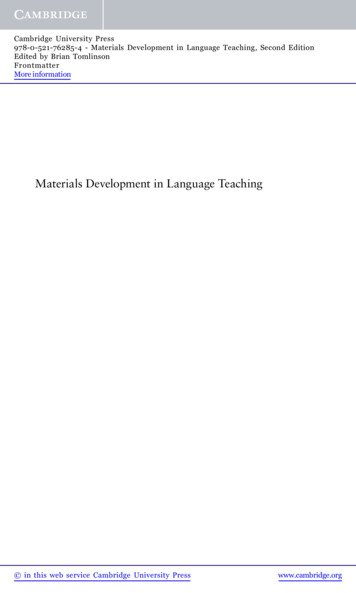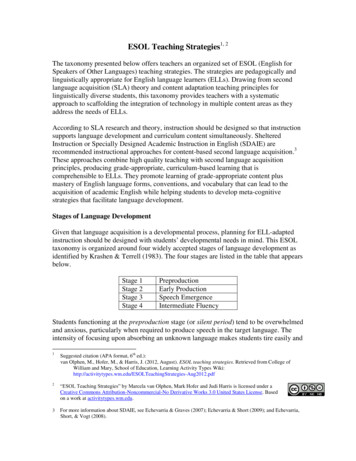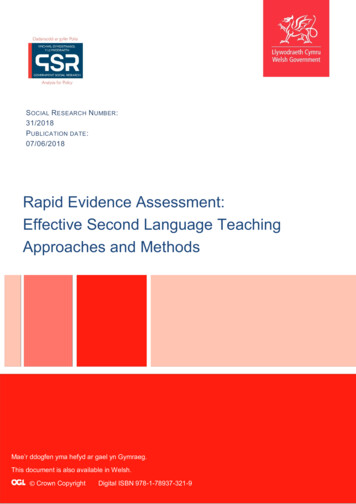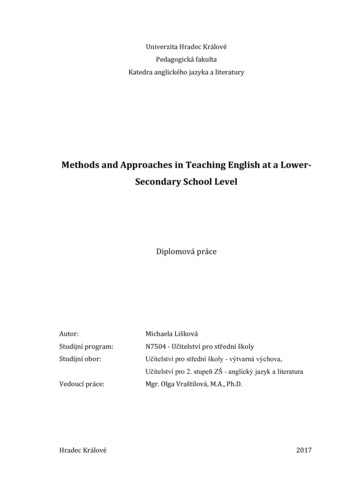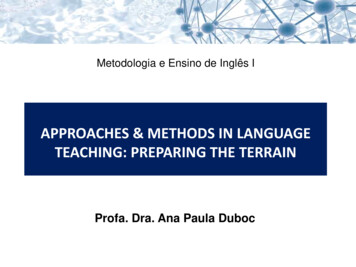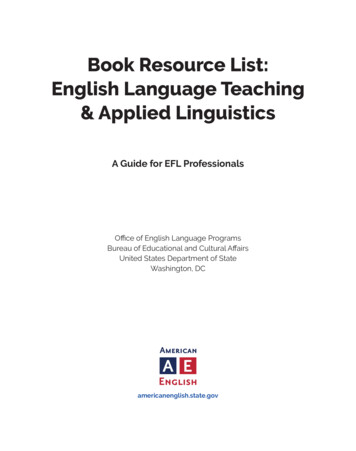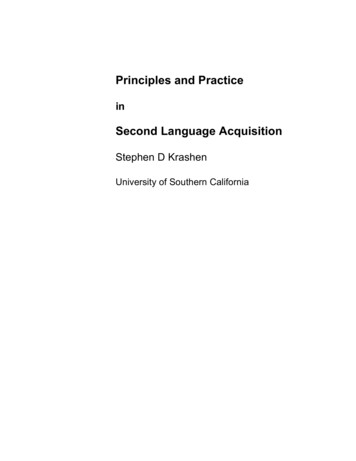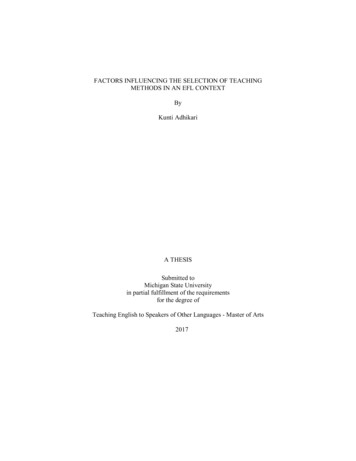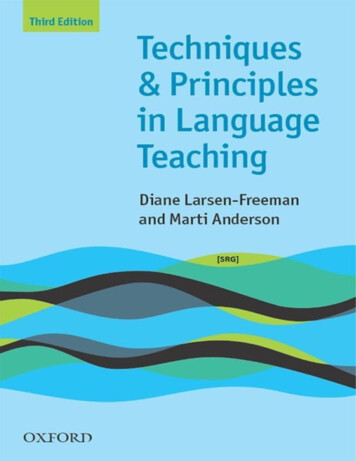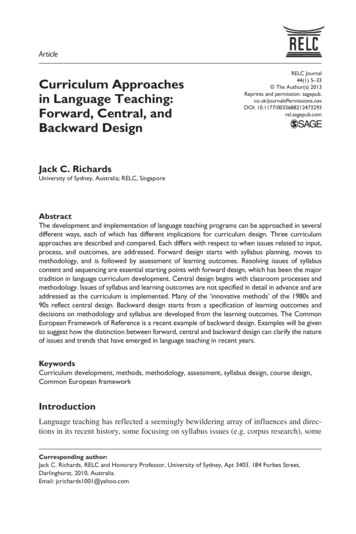
Transcription
473293REL44110.1177/0033688212473293RELC JournalRichards2013ArticleCurriculum Approachesin Language Teaching:Forward, Central, andBackward DesignRELC Journal44(1) 5–33 The Author(s) 2013Reprints and permission: sagepub.co.uk/journalsPermissions.navDOI: 10.1177/0033688212473293rel.sagepub.comJack C. RichardsUniversity of Sydney, Australia; RELC, SingaporeAbstractThe development and implementation of language teaching programs can be approached in severaldifferent ways, each of which has different implications for curriculum design. Three curriculumapproaches are described and compared. Each differs with respect to when issues related to input,process, and outcomes, are addressed. Forward design starts with syllabus planning, moves tomethodology, and is followed by assessment of learning outcomes. Resolving issues of syllabuscontent and sequencing are essential starting points with forward design, which has been the majortradition in language curriculum development. Central design begins with classroom processes andmethodology. Issues of syllabus and learning outcomes are not specified in detail in advance and areaddressed as the curriculum is implemented. Many of the ‘innovative methods’ of the 1980s and90s reflect central design. Backward design starts from a specification of learning outcomes anddecisions on methodology and syllabus are developed from the learning outcomes. The CommonEuropean Framework of Reference is a recent example of backward design. Examples will be givento suggest how the distinction between forward, central and backward design can clarify the natureof issues and trends that have emerged in language teaching in recent years.KeywordsCurriculum development, methods, methodology, assessment, syllabus design, course design,Common European frameworkIntroductionLanguage teaching has reflected a seemingly bewildering array of influences and directions in its recent history, some focusing on syllabus issues (e.g. corpus research), someCorresponding author:Jack C. Richards, RELC and Honorary Professor, University of Sydney, Apt 3403. 184 Forbes Street,Darlinghurst, 2010, Australia.Email: jcrichards1001@yahoo.com
6RELC Journal 44(1)reflecting new trends or proposals in methodology (e.g. task-based instruction), andsome with a focus on learning targets (e.g. the Common European Framework). What isit that links diverse aspects of language teaching such as these and which similarly establishes connections between such aspects of teaching and learning as notional syllabuses,Content and Language Integrated Learning and the standards movement? This paperseeks to answer these questions by examining the assumptions and practices underlyingthree different curriculum design strategies that I will refer to as forward design, centraldesign, and backward design. An understanding of the nature and implications of thesedesign approaches is helpful in arriving at a ‘big picture’ understanding of some past andpresent trends in language teaching.Input, Process, Output and the CurriculumThe term curriculum is used here to refer to the overall plan or design for a course andhow the content for a course is transformed into a blueprint for teaching and learningwhich enables the desired learning outcomes to be achieved.Curriculum takes content (from external standards and local goals) and shapes it into a plan forhow to conduct effective teaching and learning. It is thus more than a list of topics and lists ofkey facts and skills (the “input” ). It is a map of how to achieve the “outputs” of desired studentperformance, in which appropriate learning activities and assessments are suggested to make itmore likely that students achieve the desired results (Wiggins and McTighe, 2006: 6).In language teaching, Input refers to the linguistic content of a course. It seems logicalto assume that before we can teach a language, we need to decide what linguistic contentto teach. Once content has been selected it then needs to be organized into teachable andlearnable units as well as arranged in a rational sequence. The result is a syllabus. Thereare many different conceptions of a language syllabus. Different approaches to syllabusdesign reflect different understandings of the nature of language and different views asto what the essential building blocks of language proficiency are, such as vocabulary,grammar, functions or text types. Criteria for the selection of syllabus units include frequency, usefulness, simplicity, learnability and authenticity. Once input has been determined, issues concerning teaching methods and the design of classroom activities andmaterials can be addressed. These belong to the domain of process.Process refers to how teaching is carried out and constitutes the domain of methodology in language teaching. Methodology encompasses the types of learning activities,procedures and techniques that are employed by teachers when they teach and the principles that underlie the design of the activities and exercises in their textbooks and teaching resources. These procedures and principles relate to beliefs and theories concerningthe nature of language and of second language learning and the roles of teachers, learnersand instructional materials, and as ideas about language and language learning havechanged, so too have the instructional practices associated with them. Throughout thetwentieth century there was a movement away from mastery-oriented approaches focusing on the production of accurate samples of language use, to the use of more activityoriented approaches focusing on interactive and communicative classroom processes.
7RichardsOnce a set of teaching processes has been standardized and fixed in terms of principlesand associated practices it is generally referred to as a method, as in Audiolingualism orTotal Physical Response.Output refers to learning outcomes, that is, what learners are able to do as the resultof a period of instruction. This might be a targeted level of achievement on a proficiencyscale (such as the ACTFL Proficiency Scale) or on a standardized test such as TOEFL,the ability to engage in specific uses of language at a certain level of skill (such as beingable to read texts of a certain kind with a specified level of comprehension), familiaritywith the differences between two different grammatical items (such as the simple pastand the present perfect), or the ability to participate effectively in certain communicativeactivities (such as using the telephone, taking part in a business meeting, or engaging incasual conversation). Language teaching since the late nineteenth century has seen achange in the intended outputs of learning – from knowledge-based to performancebased outputs. Hence while in Europe in the nineteenth century, foreign language learning was often promoted because of the mental discipline and intellectual development itwas believed to develop in learners, in the twentieth century languages were taught formore practical goals. Today, desired learning outputs or outcomes are often described interms of objectives or in terms of performance, competencies or skills. In simple formthe components of curriculum and their relationship can be represented as ing outcomesFigure 1. Dimensions of a CurriculumThe pre-amble above provides the backdrop to the core thesis of this paper: Curriculum development in language teaching can start from input, process oroutput.Each starting point reflects different assumptions about both the means andends of teaching and learning.Conventional wisdom and practice tends to assume that decisions relating to input,process and output occur in sequence, each one dependent on what preceded it. Curriculumdevelopment from this perspective starts with a first-stage focus on input – when decisions about content and syllabus are made; moves on to a second-stage focus on methodology – when the syllabus is ‘enacted’, and then leads to a final-stage of consideration ofoutput – when means are used to measure how effectively what has been taught has beenlearned. However this view of the curriculum does not in fact reflect how language teaching has always been understood, theorized, and practiced in recent times. Much debateand discussion about effective approaches to language teaching can be better understoodby recognizing how differences in the starting points of curriculum development have
8RELC Journal 44(1)different implications and applications in language teaching. This leads to the distinctionI wish to make between forward design, central design, and backward design. Forwarddesign means developing a curriculum through moving from input, to process, and tooutput. Central design means starting with process and deriving input and output fromclassroom methodology. Backward design as the name implies, starts from output andthen deals with issues relating to process and input. The three different processes of curriculum development can thus be represented in simple form as follows:contentprocessoutcomesFigure 2. The Forward Design ProcesscontentprocessoutcomesFigure 3. The Central Design ProcesscontentoutcomesprocessFigure 4. The Backward Design ProcessEach of these curriculum development approaches will now be illustrated and examples given of how they have influenced issues and approaches in language teaching.Forward DesignForward design is based on the assumption that input, process, and output are related ina linear fashion. In other words, before decisions about methodology and output aredetermined, issues related to the content of instruction need to be resolved. Curriculumdesign is seen to constitute a sequence of stages that occur in a fixed order – an approachthat has been referred to as a ‘waterfall’ model (Tessmer and Wedman, 1990) where theoutput from one stage serves as the input to the stage that follows. This approach isdescribed in Richards and Rodgers (2001:143-44), summarizing Docking (1994):the traditional approach to developing a syllabus* involves using one’s understanding ofsubject matter as the basis for syllabus planning. One starts with the field of knowledge that oneis going to teach (e.g. contemporary European history, marketing, listening comprehension, orFrench literature) and then selects concepts, knowledge, and skills that constitute that field ofknowledge. A syllabus* and the course content are then developed around the subject.Objectives may also be specified, but these usually have little role in teaching or assessing of
Richards9the subject. Assessment of students is usually based on norm referencing, that is, students willbe graded on a single scale with the expectation that they spread across a wide range of scoresor that they conform to a pre-set distribution.[* ‘curriculum’ in North American usage and as it is used in this paper]Wiggins and McTighe (2006:15) give an illustration of this process with an exampleof a typical forward-design lesson plan: The teacher chooses a topic for a lesson (e.g. racial prejudice)The teacher selects a resource (e.g. To Kill a Mocking-bird)The teacher chooses instructional methods based on the resource and the topic(e.g. a seminar to discuss the book and cooperative groups to analyze stereotypicalimages in films and on television)The teacher chooses essay questions to assess student understanding of the book.A similar example would be a teacher planning a unit around ‘narratives’ in a writingclass. The starting point would be an understanding of the nature of narratives and theirlinguistic and discoursal features. Models of different kinds of narratives would then bestudied as preparation for students writing their own narrative texts. Assessment tasksmight involve reviewing and correcting poorly written narratives or writing further textsbased on the features that had been taught and practiced.In language teaching, forward planning is an option when the aims of learning areunderstood in very general terms such as in courses in ‘general English’ or with introductory courses at primary or secondary level where goals may be described in such terms as‘proficiency in language use across a wide range of daily situations’, or ‘communicativeability in the four language skills’. Curriculum planning in these cases involves operationalizing the notions of ‘general English’, or ‘intermediate level English’ or ‘writing skills’ interms of units that can be used as the basis for planning, teaching and assessment. This isthe approach that was adopted by the Council of Europe in the 1970s. John Trim was a keymember of the group of experts commissioned by the Council of Europe to develop a newapproach to language teaching, and he described what they wanted to achieve:We set out to identify a number of coherent but restricted goals relevant to the communicativeneeds of the learner. We then attempt to work out in detail the knowledge and skills which willequip the learner to use the language for the communicative purposes defined. In the light of hischaracteristics and resources we then have to establish a formal language program leading tothe mastery of this body of knowledge and skills, and a means of testing and evaluation toprovide feedback to all parties concerned as to the success of the programme (Trim, 1978: 9).A new approach to syllabus design was central to this enterprise.Syllabus DesignSyllabus design was a growth industry from the mid 1920s through to the latter part ofthe twentieth century and led to a number of key publications in which different
10RELC Journal 44(1)approaches to syllabus design were proposed (e.g. Wilkins, 1976; Munby, 1978; Willis,1996). Debate over criteria for the choice of syllabus items (selection) as well as criteriafor their sequencing (gradation) was a dominant issue in applied linguistics in the earlyand mid twentieth century, as described in Mackey’s (1965) influential book LanguageTeaching Analysis. Intuition, frequency counts as well as text analysis have all been usedas procedures in syllabus design.Word Lists, Grammar Syllabuses, Corpora and Discourse AnalysisEnglish language teaching has been strongly influenced by the use of lists as input toteaching. West’s General Service List (1953) identified a core set of some 2,000 lexicalitems needed to sustain language ability. Hindmarsh (1980) identified 4,500 wordsgrouped into seven levels, a similar total to the list included in the Council of Europe’sThreshold Level (Van Ek and Alexander, 1975). Lists of the core set of grammaticalitems learners needed to master were also developed such as Hornby’s Guide to Patternsand Usage in English (1954), which together with subsequent variants (e.g. Van Ek,1976) have provided the basis for the grammatical syllabuses underlying languagecourses and course books ever since. The communicative language teaching movementin the 1980s prompted attempts to shift from grammar and lexis as the primary components of a syllabus, to communicative units of syllabus organization. This led to proposals for a number of different syllabus models, including notional, functional, lexical, textand task-based-models.A more recent focus in syllabus design has been on the authenticity of the input thatis provided as a basis for teaching and the role of corpora in determining linguistic input.Reppen comments:English as a Second/Foreign Language professionals, from teachers to testing specialists,repeatedly make decisions about language, including which features and vocabulary to teach and/or test. In recent years, most ESL/EFL professionals have adopted a preference for “authentic”materials, presenting language from natural texts rather than made-up texts. Corpora provide aready source of natural, or authentic texts for language learning (Reppen, 2010: 4).Corpus analysis has revealed the importance of units beyond the level of vocabulary(e.g. phrases, multiword units and collocations) and provides information that can beused to update or replace the earlier generations of lists that have been used in syllabusdesign. O’Keefe et al., (2007: 22) suggest that ‘course book dialogues, and even entiresyllabi, can be informed by corpus data’ . Another approach that has been used to provideauthentic input to teaching is through the use of discourse analysis – a procedure that isused to study the nature of different text types, the ways they are used, and their lexical,grammatical, and textual features. This is particularly important in the design of coursesin English for Special Purposes where the identification of the lexical, syntactic andtextual structures of different genres is a pre-requisite to teaching specialized genres.ESP curricula generally focus strongly on the description and illustration of communication andlanguage use in the specialist field. Thus the language content of ESP courses is pivotal in ESP
Richards11course design. Many courses are strongly focused on language content (as opposed to content ofanother nature, such as learning strategies). Many courses have as a major objective that thestudents will have better understanding of communication and language use in the specialist fieldor target discourse community by the end of the course. Moreover, such courses generally aim tooffer realistic descriptions of discourse derived from empirical investigations of communicationand language use in the community or specialist field (Basturkmen, 2010: 36).Syllabus and MethodologyWith a forward design approach, decisions about teaching processes or methodology follow from syllabus specification. Ideally, the planner starts with a theory of language anda syllabus derived from it and then looks for a learning theory that could be used as thebasis for an appropriate pedagogy. In some cases there has been a natural link betweeninput and process, between content and method, such as the natural link between structural linguistics and behaviorist learning theory that led to both the audiolingual methodand situational language teaching and in the case of French, the audiovisual method thatwas used to teach the syllabus of le Français fundamental. However in theory a syllabusdoes not necessarily imply a particular methodology. A structural syllabus can be embodied in an audiolingual as well as a task-based course, and there are many different waysin which a text-based or functional syllabus can be taught. The point here is simply thatwith forward design, decisions about how to teach follow from decisions about the content of a course and decisions about output or learning outcomes follow from decisionsabout methodology.Two Examples of Forward Design Approaches in Language TeachingThe audiolingual method, the audiovisual method and the structural situational methodhave already been cited as examples of forward design methods. More recent examplesinclude communicative language teaching and content based teaching/CLIL:Communicative Language Teaching (CLT): the impetus for the development of CLTcame from a change in the understanding of the nature of language, prompted by Hymes’notion of communicative competence. While the concept of communicative competencewas embraced enthusiastically by the language teaching profession, an initial concern inCLT was with the operationalization of the notion of communicative competence and thedevelopment of a communicative syllabus to replace earlier grammar-based syllabus models. Trim (2012), one of the developers of the Threshold Level communicative syllabusmentioned previously, explains that it was an outcome of discussions about how to arriveat a new kind of syllabus that would reflect the theories of Hymes (communicative competence), Austin (speech acts), and Wilkins (notional analysis) and would deliver communicative competence as the outcome of teaching and learning. The result was the developmentof the syllabus that lies at the heart of Threshold level (Trim, 2012: 26). Clark suggests thatthe communicative approach still reflects the same assumptions as audiolingualism sincethey both start with a model of language that is broken down into smaller units – elementsof knowledge and part-skills. These are then sequenced from simple to more complex andbuild towards the desired learning outcomes. This approach:
12RELC Journal 44(1)has had a powerful influence in recent years on the design of foreign language curriculum. Ithas given rise to the audio-lingual, audio-visual/situational, topic-based, and functional notionalapproach to foreign language learning All of these approaches have sought to bring about aneffective communicative ability in learners as their ultimate goal, but have conceptualized thisability and the way to bring it about in different ways, adopting different organizing principlesin the design of the foreign language curriculum, The audio-lingual approach conceptualized acommunicative ability in terms of good grammatical habits. The audio/visual situationalapproach focused on the ability to understand and produce appropriate phrase related toparticular situations. Topic-based approaches emphasized the ability to cope with certain topics.The functional-notional approach has focused on mastery of formal means to interpret andexpress certain predetermined meanings (Clark, 1987: 23).The priority of syllabus specification over methodology in CLT is reflected inMunby’s (1978) Communicative Syllabus Design – an influential book in its day anddescribed as a model for specifying the syllabus content of a course based on learners’communicative needs. Methodological issues are described as a ‘dimension of coursedesign which is subsequent to syllabus specification’ (Munby, 1978: 217). The nextstep in curriculum development with the Munby model thus involves designing amethodology that is compatible with a communicative syllabus. The final stage in theprocess is the development of principles for assessment, which aim to measure howwell learners can demonstrate communicative language ability (Wier, 1990).Content-based Instruction (CoBI) and Content and Language Integrated Learning (CLIL). BothCoBI (cited as CoBI here to distinguish it from Competency-based Instruction – CpBI inthis paper) and its more recent variant CLIL are also examples of forward design. Theyseek to develop language proficiency as well the mastery of subject matter, critical thinking, and other cognitive skills through the use of a syllabus that integrates both languageand subject matter (e.g. science, geography, history, environmental studies). AlthoughCoBI and CLIL may take many different forms, as with other forward design models theprocess of developing a curriculum typically starts with the design of a syllabus that contains both content and language components. This then leads to the choice of suitableinstructional materials as well as selection of activities for delivering, reviewing and assessing instruction (Crandall, 2012:150). The following example (from Mehisto et al., 2008:50-69) illustrates in summary form the procedures used to develop a one-week science uniton volcanoes and is similar to the example from Wiggins and McTighe cited above.1.2.3.4.Content and language needed for the topic of volcanoes is identified.Aims in terms of content learning, language learning and skills learning areidentified.Resources chosen to facilitate a variety of whole class, group based and individual activities focusing on different aspects of content and language.Informal assessment procedures used to assess student learning.Like other communicative approaches, the instructional processes used in CoBI/CLILare varied and no specific teaching methods are prescribed. A range of teaching activitiesare used, depending on the type of course and its context:
13RichardsIn CoBI, teachers can draw on a range of relevant, meaningful, and engaging activities thatincrease student motivation in a more natural manner, activities that involve co-operative, taskbased, experiential, and project-based learning CoBI lessons include the use of both authentic and adapted oral and written subject mattermaterials (textbooks, audio and visual materials, and other learning materials) that areappropriate to the cognitive and language proficiency level of the learners or that can be madeaccessible through bridging activities (Crandall, 2012: 151-52).Implementing a Forward Design CurriculumThe curriculum design process associated with forward design can be represented igure 5. Implementing a Forward DesignIn some contexts the planning and development of each stage in the curriculum development process is carried out by different specialists who have expertise in each process,such as specialists in syllabus design, methodology, and assessment. Graves (2008: 150)describes this as a ‘specialist approach’, and comments:In the specialist approach, the potential for mismatch [i.e. lack of alignment between thedifferent components of the curriculum –author’s note] is great because each different group ofpeople performs different curricular functions, uses different discourses, and produces differentcurricular products.Central DesignWhile a progression from input, to process, to output would seem to be a logical approachto the planning and delivery of instruction, it is only one route that can be taken. Thesecond route I call central design. With central design, curriculum development startswith the selection of teaching activities, techniques and methods rather than with theelaboration of a detailed language syllabus or specification of learning outcomes. Issuesrelated to input and output are dealt with after a methodology has been chosen or developed or during the process of teaching itself.Clark (1987) refers to this as ‘progressivism’ and an example of a process approach tothe curriculum.We communicate, and if it is found useful we can look at the product of our efforts and discusswhat has occurred by examining the exponents and attempting to relate them to particularnotions and functions, or to lexical and grammatical categories. But this is an after-the-event
14RELC Journal 44(1)way of breaking up the flux and flow of a particular discourse, rather than means ofpredetermining what one may wish to say. This does not deny that the teacher and pupil mayneed to focus on particular elements of rhetorical, semantic, and grammatical content that arisein the discourse. It seems important to insist, however, that such focuses should arise out oflanguage in use, rather than precede them, so that learners are enabled to discover rules of use,form-meaning relationships, and formal rules and systems against the backcloth of realcontextualized discourse (Clark, 1987: 40).Research on teachers’ practices reveals that teachers often follow a central designapproach when they develop their lessons by first considering the activities and teachingprocedures they will use. Rather than starting their planning processes by detailed considerations of input or output, they start by thinking about the activities they will use inthe classroom. While they assume that the exercises and activities they make use of willcontribute to successful learning outcomes, it is the classroom processes they seek toprovide for their learners that are generally their initial focus.Thus:contentmethodologyoutcomesFigure 6. Implementing a Central DesignDespite the approach they have been recommended to use in their initial teacher education, teachers’ initial concerns are typically with what they want their learners to doduring the lesson. Later their attention turns to the kind of input and support that learnerswill need to carry out the learning activities (Pennington and Richards, 1997). This contrasts with the linear forward-design model that teachers are generally trained to follow.Summarizing research on teachers’ planning, Freeman (1996: 97) observed:[Teachers] did not naturally think about planning in the organized formats which they had beentaught to use in their professional training. Further, when they did plan lessons according tothese formats, they often did not teach them according to plan. Teachers were much more likelyto visualize lessons as clusters or sequences of activities: they would blend content with activity,and they would generally focus on their particular students. In other words, teachers tended toplan lesson as ways of doing things, for given groups of students rather than to meet particularobjectives.This is illustrated in an account of how a second language teacher approached herlessons in a study by Fujiwara, where she describes her struggle to follow the prescribedlinear forward-planning model (1996: 151): my method of planning still begins with activities and visions of the class. It’s only when Ilook at the visions that I can begin to analyse why I’m doing what I’m doing. I also need to bein dialogue with students, so it’s hard for me to design a year’s course in the abstract. Just as my
Richards15language-learning process is no longer in awareness, so my planning process is based on layersand layers of assumptions, experiences, and knowledge. I have to dig down deep to find outwhy I make the decisions I do.In general education this approach was advocated by Bruner (1966) and Stenhouse(1975) who argued that curriculum development should start by identifying the processes of inquiry and deliberation that drive teaching and learning – processes such asinvestigation, decision-making reflection, discussion, interpretation, critical thinking,making choices, co-operating with others and so on. Content is chosen on the basis ofhow it promotes the use of these processes and outcomes do not need to be specified inany degree of detail, if at all.[The curriculum] is not designed on a pre-specification of behavioural objectives. Of coursethere are changes in students as result of a course, but many of the most valued
mined, issues concerning teaching methods and the design of classroom activities and materials can be addressed. These belong to the domain of process. Process refers to how teaching is carried out and constitutes the domain of methodol - ogy in language teaching.

